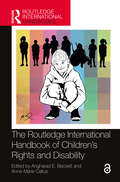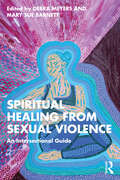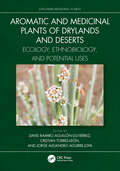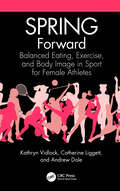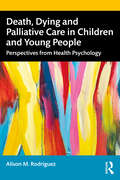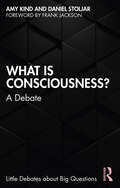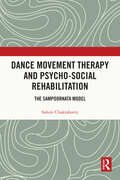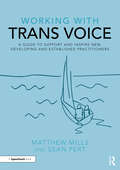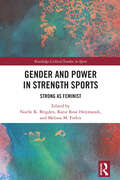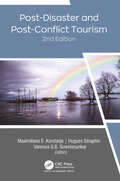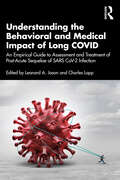- Table View
- List View
The Routledge International Handbook of Children's Rights and Disability (Routledge International Handbooks)
This handbook provides authoritative and cutting-edge analyses of various aspects of the rights and lives of disabled children around the world. Taking the UN Convention on the Rights of Persons with Disabilities (CRPD) and the UN Convention of the Rights of the Child (CRC) as conceptual frameworks, this work appraises the current state of affairs concerning the rights of disabled children across different stages of childhood, different life domains, and different socio-cultural contexts. The book is divided into four sections: Legislation and Policy Children’s Voice The Life Course in Childhood Life Domains in Childhood Comprised of 37 newly commissioned chapters featuring analyses of UN documents and case studies from Australia, Brazil, Ethiopia, Hong Kong, Italy, the Netherlands, Norway, Papua New Guinea, Serbia, South Africa, Spain, Sweden, the United Kingdom, the United States, and Vanuatu, its multidisciplinary approach reflects the complexities of the lives of disabled children and the multifarious nature of the strategies needed to ensure their rights are upheld. It will be of interest to researchers and students working in disability studies, education, allied health, law, philosophy, play studies, social policy, and the sociology of childhood. It will also be a valuable resource for professionals/practitioners, allowing them to consider future directions for ensuring that disabled children’s rights are realised and their well-being and dignity are assured.
The Routledge International Handbook of Children's Rights and Disability (Routledge International Handbooks)
by Angharad E. Beckett Anne-Marie CallusThis handbook provides authoritative and cutting-edge analyses of various aspects of the rights and lives of disabled children around the world. Taking the UN Convention on the Rights of Persons with Disabilities (CRPD) and the UN Convention of the Rights of the Child (CRC) as conceptual frameworks, this work appraises the current state of affairs concerning the rights of disabled children across different stages of childhood, different life domains, and different socio-cultural contexts. The book is divided into four sections: Legislation and Policy Children’s Voice The Life Course in Childhood Life Domains in Childhood Comprised of 37 newly commissioned chapters featuring analyses of UN documents and case studies from Australia, Brazil, Ethiopia, Hong Kong, Italy, the Netherlands, Norway, Papua New Guinea, Serbia, South Africa, Spain, Sweden, the United Kingdom, the United States, and Vanuatu, its multidisciplinary approach reflects the complexities of the lives of disabled children and the multifarious nature of the strategies needed to ensure their rights are upheld. It will be of interest to researchers and students working in disability studies, education, allied health, law, philosophy, play studies, social policy, and the sociology of childhood. It will also be a valuable resource for professionals/practitioners, allowing them to consider future directions for ensuring that disabled children’s rights are realised and their well-being and dignity are assured.
Handbook of Construction Safety, Health and Well-being in the Industry 4.0 Era
by Anil Sawhney Patrick Manu Gao Shang Paulo Jorge Da Silva Bartolo Valerie FrancisThis Handbook seeks to examine and advance current understanding of the confluence of construction health, safety and well-being and the broad range of Industry 4.0 technologies in use in the architecture, engineering and construction (AEC) industry. Globally, the construction sector accounts for more than 100,000 occupational fatalities annually. In many countries, reports of work-related accidents, injuries and illnesses are commonplace, and there is an urgent need to improve the occupational safety and health (OSH) outlook of the construction sector. The fourth industrial revolution presents opportunities to leverage modern technologies (e.g., big data, artificial intelligence, automation, sensors, AR, VR and robotics) to improve the poor OSH performance of the construction industry. However, embracing such technologies could also induce unintended adverse consequences for the safety, health and well-being of construction workers. Therefore, the realisation of the opportunities as well as the mitigation of potentially adverse consequences requires research-informed holistic insights around the union of Industry 4.0 and construction occupational safety and health management. This cutting-edge volume addresses a significant gap in literature by bringing together experienced academics and researchers to highlight the drivers, opportunities and drawbacks of the merging of Industry 4.0 with construction health, safety and well-being. After a detailed introductory section which highlights key issues and challenges, section one covers the application of a broad range of digital technologies; then section two discusses the application of industrial production and cyber physical systems in the context of construction safety and health management. Readers from a broad range of AEC backgrounds as well as safety professionals and technologists will come to understand how the technologies are applied and the resulting OSH benefits as well as potential drawbacks.
Handbook of Construction Safety, Health and Well-being in the Industry 4.0 Era
by Patrick Manu Shang Gao Paulo Jorge Da Silva Bartolo Valerie Francis Anil SawhneyThis Handbook seeks to examine and advance current understanding of the confluence of construction health, safety and well-being and the broad range of Industry 4.0 technologies in use in the architecture, engineering and construction (AEC) industry. Globally, the construction sector accounts for more than 100,000 occupational fatalities annually. In many countries, reports of work-related accidents, injuries and illnesses are commonplace, and there is an urgent need to improve the occupational safety and health (OSH) outlook of the construction sector. The fourth industrial revolution presents opportunities to leverage modern technologies (e.g., big data, artificial intelligence, automation, sensors, AR, VR and robotics) to improve the poor OSH performance of the construction industry. However, embracing such technologies could also induce unintended adverse consequences for the safety, health and well-being of construction workers. Therefore, the realisation of the opportunities as well as the mitigation of potentially adverse consequences requires research-informed holistic insights around the union of Industry 4.0 and construction occupational safety and health management. This cutting-edge volume addresses a significant gap in literature by bringing together experienced academics and researchers to highlight the drivers, opportunities and drawbacks of the merging of Industry 4.0 with construction health, safety and well-being. After a detailed introductory section which highlights key issues and challenges, section one covers the application of a broad range of digital technologies; then section two discusses the application of industrial production and cyber physical systems in the context of construction safety and health management. Readers from a broad range of AEC backgrounds as well as safety professionals and technologists will come to understand how the technologies are applied and the resulting OSH benefits as well as potential drawbacks.
Spiritual Healing from Sexual Violence: An Intersectional Guide
by Debra Meyers Mary Sue BarnettSpiritual Healing from Sexual Violence: An Intersectional Guide is a collection of essays from survivors, scholars, activists, spiritual leaders, and social justice practitioners that offers numerous intersectional and culturally competent options for women, men, and non-binary conforming adults to create their own safe healing conditions and establish pathways for recovery. These chapters provide a wide range of survival stories that raise awareness of the issues involved in healing after sexual assault and also provide inspiration for reforming negative societal issues and patterns. In a classroom setting, these chapters deliver both the culturally grounded knowledge and the skillsets necessary for recovery. This is a vital guide for students and practitioners in counseling, social work, theology, and gender studies.
Spiritual Healing from Sexual Violence: An Intersectional Guide
by Debra Meyers Mary Sue BarnettSpiritual Healing from Sexual Violence: An Intersectional Guide is a collection of essays from survivors, scholars, activists, spiritual leaders, and social justice practitioners that offers numerous intersectional and culturally competent options for women, men, and non-binary conforming adults to create their own safe healing conditions and establish pathways for recovery. These chapters provide a wide range of survival stories that raise awareness of the issues involved in healing after sexual assault and also provide inspiration for reforming negative societal issues and patterns. In a classroom setting, these chapters deliver both the culturally grounded knowledge and the skillsets necessary for recovery. This is a vital guide for students and practitioners in counseling, social work, theology, and gender studies.
Aromatic and Medicinal Plants of Drylands and Deserts: Ecology, Ethnobiology, and Potential Uses (Exploring Medicinal Plants)
by David Ramiro Aguillón-Gutiérrez Cristian Torres-León Jorge Alejandro Aguirre-JoyaThe description and analysis of the Mexican and other countries desertic plants from the point of view of their use in traditional medicine and their potential use in integrative medicine is the overall theme of this book. Aromatic and Medicinal Plants of Drylands and Deserts: Ecology, Ethnobiology and Potential Uses describes the historic use of drylands plants, botanical and geological classification, also describes the endemic plants used in traditional medicine, going through the most relevant aspects of biomedicine and integrative medicine. The chemical and bioactive compounds from desertic medicinal and aromatic plants and the analytic techniques to determine chemical and bioactive compounds from the medicinal and aromatic plants are reviewed. Ethnobiology is detailed in the present book as well as the importance of the integrative medicine for the ancient and actual cultures. The book represents an effort to keep the ethnobiological knowledge of communities for the use of traditional desertic plants with the actual analytical techniques to unveil the chemical molecules responsible of the biological or biomedical applications. Features: • Describes the endemic plants used in traditional medicine • Includes the chemical and bioactive compounds from desertic medicinal plants • Addresses the analytic techniques to determine chemical and bioactive compounds • Represents an effort to keep the ethnobiological knowledge of communities To execute this book, there are collaborations by authors from different institutions in northern Mexico, which is where the arid and semi-arid ecosystems of the country are found. Although the subject of medicinal plants has been treated from different angles, this book offers a holistic and comprehensive vision of these important organisms of the Mexican desert, thus resulting in an updated work for specialized readers and for those who are beginning in this exciting theme.
Aromatic and Medicinal Plants of Drylands and Deserts: Ecology, Ethnobiology, and Potential Uses (Exploring Medicinal Plants)
by David Ramiro Aguillón-Gutiérrez, Cristian Torres-León, and Jorge Alejandro Aguirre-JoyaThe description and analysis of the Mexican and other countries desertic plants from the point of view of their use in traditional medicine and their potential use in integrative medicine is the overall theme of this book. Aromatic and Medicinal Plants of Drylands and Deserts: Ecology, Ethnobiology and Potential Uses describes the historic use of drylands plants, botanical and geological classification, also describes the endemic plants used in traditional medicine, going through the most relevant aspects of biomedicine and integrative medicine. The chemical and bioactive compounds from desertic medicinal and aromatic plants and the analytic techniques to determine chemical and bioactive compounds from the medicinal and aromatic plants are reviewed. Ethnobiology is detailed in the present book as well as the importance of the integrative medicine for the ancient and actual cultures. The book represents an effort to keep the ethnobiological knowledge of communities for the use of traditional desertic plants with the actual analytical techniques to unveil the chemical molecules responsible of the biological or biomedical applications. Features: • Describes the endemic plants used in traditional medicine • Includes the chemical and bioactive compounds from desertic medicinal plants • Addresses the analytic techniques to determine chemical and bioactive compounds • Represents an effort to keep the ethnobiological knowledge of communities To execute this book, there are collaborations by authors from different institutions in northern Mexico, which is where the arid and semi-arid ecosystems of the country are found. Although the subject of medicinal plants has been treated from different angles, this book offers a holistic and comprehensive vision of these important organisms of the Mexican desert, thus resulting in an updated work for specialized readers and for those who are beginning in this exciting theme.
Work, Health and Wellbeing in the Construction Industry
by Helen Lingard Michelle TurnerThis book covers a wide range of topics relating to the health and wellbeing of the construction workforce. Based on more than two decades of work examining various aspects of workers’ health and wellbeing, the book addresses a key topic in construction management: how the design of work environments, construction processes and organisation of work impact upon construction workers’ physical and psychological health. Occupational health is a significant problem for the construction industry. However, the subject of health does not receive as much attention in occupational health and safety research or practice as the subject of safety. Traditional management approaches (focused on the prevention of accidents and injuries) are arguably ill-suited to addressing issues of workers’ health and wellbeing. This book seeks to explain how workers' health and wellbeing are impacted by working in the construction industry, and suggest ways in which organisations (and decision makers within them) can positively shape workplaces and practices in ways that better support constructions workers to maintain healthy and productive working lives. Including chapter summaries and discussion questions to encourage student readers to reflect on and formulate their own viewpoints about the issues raised in each chapter, the book has the potential to be used as a textbook in undergraduate or postgraduate occupational health and safety, or construction management courses dealing with occupational health and safety. It could also be used as supplementary recommended reading in undergraduate or postgraduate programmes in architecture, engineering or management.
Work, Health and Wellbeing in the Construction Industry
by Helen Lingard Michelle TurnerThis book covers a wide range of topics relating to the health and wellbeing of the construction workforce. Based on more than two decades of work examining various aspects of workers’ health and wellbeing, the book addresses a key topic in construction management: how the design of work environments, construction processes and organisation of work impact upon construction workers’ physical and psychological health. Occupational health is a significant problem for the construction industry. However, the subject of health does not receive as much attention in occupational health and safety research or practice as the subject of safety. Traditional management approaches (focused on the prevention of accidents and injuries) are arguably ill-suited to addressing issues of workers’ health and wellbeing. This book seeks to explain how workers' health and wellbeing are impacted by working in the construction industry, and suggest ways in which organisations (and decision makers within them) can positively shape workplaces and practices in ways that better support constructions workers to maintain healthy and productive working lives. Including chapter summaries and discussion questions to encourage student readers to reflect on and formulate their own viewpoints about the issues raised in each chapter, the book has the potential to be used as a textbook in undergraduate or postgraduate occupational health and safety, or construction management courses dealing with occupational health and safety. It could also be used as supplementary recommended reading in undergraduate or postgraduate programmes in architecture, engineering or management.
SPRING Forward: Balanced Eating, Exercise, and Body Image in Sport for Female Athletes
by Kathryn Vidlock Catherine Liggett Andrew DoleMany female athletes struggle with body confidence and change their nutrition in unhealthy ways, only to the detriment of both their performance and their health. SPRING Forward: Balanced Eating, Exercise, and Body Image in Sport for Female Athletes provides performance nutrition and body image flexibility guidance for adolescent and adult female athletes. This book details the problems and the consequences, and provides extensive education on healthier, higher-quality performance. Nutritional details include specific nutritional needs for female athletes related to hormones and nutrition for peak performance, as well as fad diets. Body image education includes societal pressure, unrealistic ideals, handling mental aspects of body image, psychological obstacles, and dealing with more severe problems. Healthy performance is addressed along with sleep, camaraderie, and how to manage the ups and downs of being a female athlete. Several instructional manuals that can be easily used for teams at any level, from secondary school to elite athletes, are included in the book. Secondary school athletes who used the program showed significant improvement in body image flexibility and gave the program rave reviews, stating that not only were they stronger athletes, but their teams also felt the education was a bonding experience.
SPRING Forward: Balanced Eating, Exercise, and Body Image in Sport for Female Athletes
by Kathryn Vidlock Catherine Liggett Andrew DoleMany female athletes struggle with body confidence and change their nutrition in unhealthy ways, only to the detriment of both their performance and their health. SPRING Forward: Balanced Eating, Exercise, and Body Image in Sport for Female Athletes provides performance nutrition and body image flexibility guidance for adolescent and adult female athletes. This book details the problems and the consequences, and provides extensive education on healthier, higher-quality performance. Nutritional details include specific nutritional needs for female athletes related to hormones and nutrition for peak performance, as well as fad diets. Body image education includes societal pressure, unrealistic ideals, handling mental aspects of body image, psychological obstacles, and dealing with more severe problems. Healthy performance is addressed along with sleep, camaraderie, and how to manage the ups and downs of being a female athlete. Several instructional manuals that can be easily used for teams at any level, from secondary school to elite athletes, are included in the book. Secondary school athletes who used the program showed significant improvement in body image flexibility and gave the program rave reviews, stating that not only were they stronger athletes, but their teams also felt the education was a bonding experience.
Death, Dying and Palliative Care in Children and Young People: Perspectives from Health Psychology
by Alison M. RodriguezDeath, Dying and Palliative Care in Children and Young People: Perspectives from Health Psychology examines the issues relevant to children and young people living with serious illness and their families by taking a closer look at the literature and knowledge around the processes of care, health, well-being and development through a health psychology lens. The text introduces readers to the general palliative and holistic care needs of children and young people along with the nuances of caring relationships. The chapters discuss the vulnerabilities encountered in living with serious illness and facing a shortened life prognosis, being at the end of life, and issues relative to the historical concept of the ‘good death’ or ‘dying well’, grief, and bereavement. The author examines how individual and familial experiences can be multi-layered, which can consequently influence perceptions and behaviours. The text therefore offers a deep exploration of the varied ways in which people draw on different resources to navigate their palliative care lived experiences. The book will be beneficial to the students of, and individuals interested in, psychology and nursing along with other health and social care courses. It will further be of interest to individuals interested in gaining more understanding of the experiential aspects of death, dying and palliative care in children and young people from health psychology perspectives.
Death, Dying and Palliative Care in Children and Young People: Perspectives from Health Psychology
by Alison M. RodriguezDeath, Dying and Palliative Care in Children and Young People: Perspectives from Health Psychology examines the issues relevant to children and young people living with serious illness and their families by taking a closer look at the literature and knowledge around the processes of care, health, well-being and development through a health psychology lens. The text introduces readers to the general palliative and holistic care needs of children and young people along with the nuances of caring relationships. The chapters discuss the vulnerabilities encountered in living with serious illness and facing a shortened life prognosis, being at the end of life, and issues relative to the historical concept of the ‘good death’ or ‘dying well’, grief, and bereavement. The author examines how individual and familial experiences can be multi-layered, which can consequently influence perceptions and behaviours. The text therefore offers a deep exploration of the varied ways in which people draw on different resources to navigate their palliative care lived experiences. The book will be beneficial to the students of, and individuals interested in, psychology and nursing along with other health and social care courses. It will further be of interest to individuals interested in gaining more understanding of the experiential aspects of death, dying and palliative care in children and young people from health psychology perspectives.
What is Consciousness?: A Debate (Little Debates about Big Questions)
by Amy Kind Daniel StoljarWhat is consciousness and why is it so philosophically and scientifically puzzling? For many years philosophers approached this question assuming a standard physicalist framework on which consciousness can be explained by contemporary physics, biology, neuroscience, and cognitive science. This book is a debate between two philosophers who are united in their rejection of this kind of "standard" physicalism—but who differ sharply in what lesson to draw from this. Amy Kind defends dualism 2.0, a thoroughly modern version of dualism (the theory that there are two fundamentally different kinds of things in the world: those that are physical and those that are mental) decoupled from any religious or non-scientific connotations. Daniel Stoljar defends non-standard physicalism, a kind of physicalism different from both the standard version and dualism 2.0. The book presents a cutting-edge assessment of the philosophy of consciousness and provides a glimpse at what the future study of this area might bring. Key Features Outlines the different things people mean by "consciousness" and provides an account of what consciousness is. Reviews the key arguments for thinking that consciousness is incompatible with physicalism. Explores and provides a defense of contrasting responses to those arguments, with a special focus on responses that reject the standard physicalist framework. Provides an account of the basic aims of the science of consciousness. Written in a lively and accessibly style. Includes a comprehensive glossary.
What is Consciousness?: A Debate (Little Debates about Big Questions)
by Amy Kind Daniel StoljarWhat is consciousness and why is it so philosophically and scientifically puzzling? For many years philosophers approached this question assuming a standard physicalist framework on which consciousness can be explained by contemporary physics, biology, neuroscience, and cognitive science. This book is a debate between two philosophers who are united in their rejection of this kind of "standard" physicalism—but who differ sharply in what lesson to draw from this. Amy Kind defends dualism 2.0, a thoroughly modern version of dualism (the theory that there are two fundamentally different kinds of things in the world: those that are physical and those that are mental) decoupled from any religious or non-scientific connotations. Daniel Stoljar defends non-standard physicalism, a kind of physicalism different from both the standard version and dualism 2.0. The book presents a cutting-edge assessment of the philosophy of consciousness and provides a glimpse at what the future study of this area might bring. Key Features Outlines the different things people mean by "consciousness" and provides an account of what consciousness is. Reviews the key arguments for thinking that consciousness is incompatible with physicalism. Explores and provides a defense of contrasting responses to those arguments, with a special focus on responses that reject the standard physicalist framework. Provides an account of the basic aims of the science of consciousness. Written in a lively and accessibly style. Includes a comprehensive glossary.
Dance Movement Therapy and Psycho-social Rehabilitation: The Sampoornata Model
by Sohini ChakrabortyThis book looks at the psychotherapeutic effects of Dance Movement Therapy (DMT) with a focus on the experiences of survivors of gender-based violence and their social development, psycho-social rehabilitation, and reintegration within society. The author, a sociologist and dancer, uses a model she calls Sampoornata— or Fulfilment, to merge sociology and dance in order to help survivors of sexual violence overcome their trauma. Sampoornata was developed to help survivors of gender-based violence and trafficking, by focusing on their specific needs, and helping them to express themselves and overcome emotional and psychological pain. Through interviews with and detailed narratives of survivors, the book takes the readers through the development of the model, its implementation, practice, and impact on their lives. Situated within the social, cultural, as well as geographical context of India, the book is an important resource for rethinking the creative approaches, theories, and practice of DMT worldwide. This book will be of interest to researchers and students of psychology, psychotherapy, dance and movement studies, and to those who work with dance and movement therapy. It will also be useful for professionals working in the areas of gender violence, trafficking, trauma, psycho-social rehabilitation, and well-being.
Dance Movement Therapy and Psycho-social Rehabilitation: The Sampoornata Model
by Sohini ChakrabortyThis book looks at the psychotherapeutic effects of Dance Movement Therapy (DMT) with a focus on the experiences of survivors of gender-based violence and their social development, psycho-social rehabilitation, and reintegration within society. The author, a sociologist and dancer, uses a model she calls Sampoornata— or Fulfilment, to merge sociology and dance in order to help survivors of sexual violence overcome their trauma. Sampoornata was developed to help survivors of gender-based violence and trafficking, by focusing on their specific needs, and helping them to express themselves and overcome emotional and psychological pain. Through interviews with and detailed narratives of survivors, the book takes the readers through the development of the model, its implementation, practice, and impact on their lives. Situated within the social, cultural, as well as geographical context of India, the book is an important resource for rethinking the creative approaches, theories, and practice of DMT worldwide. This book will be of interest to researchers and students of psychology, psychotherapy, dance and movement studies, and to those who work with dance and movement therapy. It will also be useful for professionals working in the areas of gender violence, trafficking, trauma, psycho-social rehabilitation, and well-being.
Working with Trans Voice: A Guide to Support and Inspire New, Developing and Established Practitioners (Working With)
by Matthew Mills Sean PertThis book is an essential resource for those new to, developing and established in the field of trans voice. Presented in a workbook style and packed with practical exercises for the practitioner to engage with, it explores and explains how to work with clients effectively, while also developing vital cultural knowledge and fundamental skills in voice coaching that will help the practitioner develop insight into and support each person’s unique journey. Matthew Mills and Sean Pert draw on their wealth of experience to encourage the reader to consider what gender means to them, and how gender performance may be taken for granted by people whose gender identity aligns with their sex assigned at birth. The key learning points of this book are illustrated by guiding comments from trans and non-binary people with lived, practical and clinical experience Based on the latest expert practice and informed by the experiences of the clients themselves, Working with Trans Voice allows speech and language therapists and other professionals interested in supporting trans and gender-diverse people to develop the confidence to work with their clients in partnership and solidarity.
Working with Trans Voice: A Guide to Support and Inspire New, Developing and Established Practitioners (Working With)
by Matthew Mills Sean PertThis book is an essential resource for those new to, developing and established in the field of trans voice. Presented in a workbook style and packed with practical exercises for the practitioner to engage with, it explores and explains how to work with clients effectively, while also developing vital cultural knowledge and fundamental skills in voice coaching that will help the practitioner develop insight into and support each person’s unique journey. Matthew Mills and Sean Pert draw on their wealth of experience to encourage the reader to consider what gender means to them, and how gender performance may be taken for granted by people whose gender identity aligns with their sex assigned at birth. The key learning points of this book are illustrated by guiding comments from trans and non-binary people with lived, practical and clinical experience Based on the latest expert practice and informed by the experiences of the clients themselves, Working with Trans Voice allows speech and language therapists and other professionals interested in supporting trans and gender-diverse people to develop the confidence to work with their clients in partnership and solidarity.
Gender and Power in Strength Sports: Strong As Feminist (Routledge Critical Studies in Sport)
by Noelle K. Brigden Katie Rose Hejtmanek Melissa M. ForbisThis book explores strength sports as a site of political contestation and a platform for insurgent gender practices. It contributes to our understanding of key themes in the study of sport, such as feminism, power, the body and identity. Drawing together interdisciplinary work spanning political science, sociology, gender studies, and biological and cultural anthropology, the book argues that in the face of ongoing embodied precarity, strength sports have become a complex form of both resistance to, and reproduction of, patriarchy. This argument also challenges traditional understandings and definitions of “strength.” Covering recreational-level participation and elite athletics, across experiential/individual, local, national, transnational, and global scales, the book explores diverse topics such as the pregnant strength athlete, the status of trans women in strength sports, and the gendered dimensions of online fitness communities during the COVID-19 pandemic. In so doing, it traces power dynamics and the interplay among multiple oppressions. Showcasing important empirical and activist research, this book is fascinating reading for anybody with an interest in women’s sport, women’s studies, gender studies, the sociology of sport, strength and conditioning, feminist politics, or cultural studies.
Gender and Power in Strength Sports: Strong As Feminist (Routledge Critical Studies in Sport)
by Noelle K. Brigden Katie Rose Hejtmanek Melissa M. ForbisThis book explores strength sports as a site of political contestation and a platform for insurgent gender practices. It contributes to our understanding of key themes in the study of sport, such as feminism, power, the body and identity. Drawing together interdisciplinary work spanning political science, sociology, gender studies, and biological and cultural anthropology, the book argues that in the face of ongoing embodied precarity, strength sports have become a complex form of both resistance to, and reproduction of, patriarchy. This argument also challenges traditional understandings and definitions of “strength.” Covering recreational-level participation and elite athletics, across experiential/individual, local, national, transnational, and global scales, the book explores diverse topics such as the pregnant strength athlete, the status of trans women in strength sports, and the gendered dimensions of online fitness communities during the COVID-19 pandemic. In so doing, it traces power dynamics and the interplay among multiple oppressions. Showcasing important empirical and activist research, this book is fascinating reading for anybody with an interest in women’s sport, women’s studies, gender studies, the sociology of sport, strength and conditioning, feminist politics, or cultural studies.
Post-Disaster and Post-Conflict Tourism, 2nd Edition
This new volume, Post-Disaster and Post-Conflict Tourism, now going into its 2nd edition, takes an in-depth look at how global geopolitical tensions and global threats affect the tourism industry and offers tools and strategies for meeting these challenges. The book is updated with chapters that include new research, studies, and experiences, many of which consider the fall-out from the COVID-19 pandemic on tourism. It also includes five brand new chapters, for over 50 new pages of text. With chapters by well-versed scholars who have worked as experts in post-disaster and post-conflict tourism, the book presents a host of case scenarios along with innovative strategies that can be implemented by postcolonial, post-conflict, and post-disaster destinations to encourage travel and tourism in these areas. Topics include using tourism as a vehicle for economic recovery, educating tourists at the pre-visit stage, developing and employing postcolonial branding and self-branding, using sports tourism and food events as a marketing strategy, the ethics revolving around post-disaster consumption, and much more. The new chapters discuss tourism in the age of the coronavirus pandemic and its dramatic disruptive effect on the tourism industry. The authors delve into post-COVID tourism marketing, health and wellness education and practices, ethical considerations for tourism operators, and more. A chapter also considers the challenges of sustainable supply chain management in tour operations. With contributions from experts in this emerging field, this volume is a rich resource for travel and tourism professionals, policymakers, researchers, and others. It creates a bridge between the conceptual discussions around "dark consumption" (tourism directed to places that are identified with death and suffering) and the urgency to develop empirical models that support destination marketing organizations in a rapidly changing world.
Post-Disaster and Post-Conflict Tourism, 2nd Edition: Toward A New Management Approach
by Maximiliano E. Korstanje Hugues Séraphin Vanessa G. B. GowreesunkarThis new volume, Post-Disaster and Post-Conflict Tourism, now going into its 2nd edition, takes an in-depth look at how global geopolitical tensions and global threats affect the tourism industry and offers tools and strategies for meeting these challenges. The book is updated with chapters that include new research, studies, and experiences, many of which consider the fall-out from the COVID-19 pandemic on tourism. It also includes five brand new chapters, for over 50 new pages of text. With chapters by well-versed scholars who have worked as experts in post-disaster and post-conflict tourism, the book presents a host of case scenarios along with innovative strategies that can be implemented by postcolonial, post-conflict, and post-disaster destinations to encourage travel and tourism in these areas. Topics include using tourism as a vehicle for economic recovery, educating tourists at the pre-visit stage, developing and employing postcolonial branding and self-branding, using sports tourism and food events as a marketing strategy, the ethics revolving around post-disaster consumption, and much more. The new chapters discuss tourism in the age of the coronavirus pandemic and its dramatic disruptive effect on the tourism industry. The authors delve into post-COVID tourism marketing, health and wellness education and practices, ethical considerations for tourism operators, and more. A chapter also considers the challenges of sustainable supply chain management in tour operations. With contributions from experts in this emerging field, this volume is a rich resource for travel and tourism professionals, policymakers, researchers, and others. It creates a bridge between the conceptual discussions around "dark consumption" (tourism directed to places that are identified with death and suffering) and the urgency to develop empirical models that support destination marketing organizations in a rapidly changing world.
Understanding the Behavioral and Medical Impact of Long COVID: An Empirical Guide to Assessment and Treatment of Post-Acute Sequelae of SARS CoV-2 Infection
Understanding the Behavioral and Medical Impact of Long COVID serves to expand the research around the illness in order to enable health care researchers and practitioners to address the questions that are imperative to individuals suffering from this condition. Through its multi-faceted approach, the book puts forth a maturation of research and interventions that are theoretically sound, empirically valid, innovative, and creative in the Long COVID area. As a scholarly and scientific compilation of Long COVID symptoms and related disorders, this book offers unparalleled insight into the critical developments across medical areas treating this illness. It helps to fill the space that the pandemic had created for knowledge of the condition, and contributes to the emerging emphasis on translational research blending the social sciences and biological fields. By putting forth the most optimal medical care practices in the treatment of complex Long COVID symptoms, this practical anthology will serve as a guide for practicing clinicians in assessment as well as treatment. It will also benefit researchers aiming to gain more understanding of Long COVID through its discussion around the critical developments in other medical areas treating the condition, and paves the way for the collaboration and future research needed to best support the global effort to mitigate the effects of this illness. This book will be essential reading for academics, practitioners, and researchers. It will appeal to individuals engaging with the fields of medicine, public policy, psychology, and for researchers looking to gain clarity about our current understanding of Long COVID. It will further be of interest to public/government agencies, nonprofit organizations, and the general public wanting to gain more information about these ambiguous and evasive symptoms.
